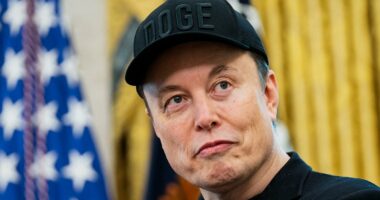Share this @internewscast.com

A former DOGE employee claims he was fired from Elon Musk’s cost-cutting department just one day after his simple claim that ‘the government works’ was published in an interview. Sahil Lavingia (pictured) posted to his blog Wednesday that he had been fired after speaking to Fast Company about his work at DOGE and what he has discovered about the federal government.

Lavingia claimed that he found fewer inefficiencies than he expected while working as a senior advisor to the chief of staff. ‘I would say the culture shock is mostly a lot of meetings, not a lot of decisions,’ said Lavingia, an engineer and the CEO of tech startup Gumroad. ‘But honestly, it’s kind of fine – because the government works. It’s not as inefficient as I was expecting, to be honest. I was hoping for more easy wins.’

Lavingia had worked at the Department of Veterans Affairs, extracting employee data and working to implement artificial intelligence over the course of 55 days before he was given the boot. During that time, he said, he became increasingly frustrated by the lack of knowledge sharing within DOGE and what he called a lack of a team culture.
![In one instance, he recounted how Elon Musk asked all DOGE employees how they could improve the public's perception of the agency amid fiery protests - at which Lavingia suggested he open-source his work and Musk agreed. 'The reality was setting in: DOGE was more like having McKinsey [management consulting] volunteers embedded in agencies rather than the revolutionary force I'd imagined,' he wrote. 'It was Elon (in the White House), Steven Davis (coordinating) and everyone else scattered across agencies.' He noted that he had decided to join DOGE to make a difference in the federal government - and did have some limited successes.](https://i.dailymail.co.uk/1s/2025/05/30/18/98877793-14764653-In_one_instance_he_recounted_how_Elon_Musk_asked_all_DOGE_employ-a-121_1748626291828.jpg)
In one instance, he recounted how Elon Musk asked all DOGE employees how they could improve the public’s perception of the agency amid fiery protests – at which Lavingia suggested he open-source his work and Musk agreed. ‘The reality was setting in: DOGE was more like having McKinsey [management consulting] volunteers embedded in agencies rather than the revolutionary force I’d imagined,’ he wrote. ‘It was Elon (in the White House), Steven Davis (coordinating) and everyone else scattered across agencies.’ He noted that he had decided to join DOGE to make a difference in the federal government – and did have some limited successes.

To help review contracts at the Department of Veterans Affairs, Lavingia said he used a large language model to flag some for potential cancelation. He also said he built tools to help the VA with its layoff efforts and worked to speed up the agency’s use of artificial intelligence – and improve the internal ChatGPT tool on the VA’s website. However, he claimed he ‘was never able to get approval to ship anything to production that would actually improve American lives – while also saving money for the American taxpayer’ even though he had developed several prototypes. Many of the longtime employees at the department were distrustful of him and the Department of Government Efficiency’s efforts, as they worried about Lavingia’s lack of understanding of the agency and its normal procedures, WIRED previously reported.
![At the same time, though, Lavingia said he was surprised to see what the department was already working on. 'In meetings with the Office of the [Chief Technology Officer], I discovered ambitious ongoing software projects like reducing veterans' benefits claims from 1333 days to under a week,' he shared. 'I also learned that several of VA's cod repos were already open-source, and the world's first electronic health record system, VistA, was built by VA employees over 40 years ago.' Reflecting back on his time at the Department of Government Efficiency, Lavingia said he 'learned a lot and got to write some code for the federal government. 'For that, I'm grateful,' the Gumroad CEO wrote. 'But I'm also disappointed. I didn't make any progress on improving the UX of veterans' filing disability claims or automating/speeding up claims processing like I had hoped to when I started.'](https://i.dailymail.co.uk/1s/2025/05/30/18/98877893-14764653-At_the_same_time_though_Lavingia_said_he_was_surprised_to_see_wh-a-122_1748626291828.jpg)
At the same time, though, Lavingia said he was surprised to see what the department was already working on. ‘In meetings with the Office of the [Chief Technology Officer], I discovered ambitious ongoing software projects like reducing veterans’ benefits claims from 1333 days to under a week,’ he shared. ‘I also learned that several of VA’s cod repos were already open-source, and the world’s first electronic health record system, VistA, was built by VA employees over 40 years ago.’ Reflecting back on his time at the Department of Government Efficiency, Lavingia said he ‘learned a lot and got to write some code for the federal government. ‘For that, I’m grateful,’ the Gumroad CEO wrote. ‘But I’m also disappointed. I didn’t make any progress on improving the UX of veterans’ filing disability claims or automating/speeding up claims processing like I had hoped to when I started.’

Lavingia’s essay came the same day Musk abruptly announced he was leaving his position as the head of DOGE – ahead of his scheduled departure. The Tesla boss had spent the last few weeks slowly phasing out of politics amid whispers of tensions with top Trump officials. The situation came to a head on Tuesday night when Musk laid into Trump’s ‘big beautiful bill’ and admitted he was disappointed with the treatment his DOGE team had received. ‘It undermines the work that the DOGE team is doing,’ Musk bluntly told CBS of the $3.8trillion spending bill.

Musk – who spoke to multiple outlets about the White House betrayal – went on to decry the treatment he and his baby-faced DOGE henchmen had received. ‘DOGE is just becoming the whipping boy for everything,’ he told the Washington Post. ‘Something bad would happen anywhere, and we would get blamed for it even if we had nothing to do with it.’

Several other high-ranking officials have since followed Musk’s lead, with Katie Miller (pictured)- who had served as an adviser to President Trump and the spokeswoman for the Department of Government Efficiency – reportedly joining Musk in the private sector. She is now reportedly helping Musk set up media interviews unrelated to his government work as he officially quit his position as the head of DOGE, an insider told CNN. The White House also confirmed on Wednesday that Steve Davis left his role as the number two man at DOGE, where he handled the day-to-day operations including hiring and firing.

He reportedly took his cues from Musk about which agencies to cut, and worked to ensure those were carried out by DOGE staffers, those familiar with the internal workings of DOGE told the Wall Street Journal. But Davis had also reportedly been planning to focus more on modernizing the government’s aging computer systems. A third DOGE leader, Brad Smith, is said to have also returned to the private sector. During his time at DOGE, Smith – a healthcare executive – had been stationed at the Department of Health and Human Services.








